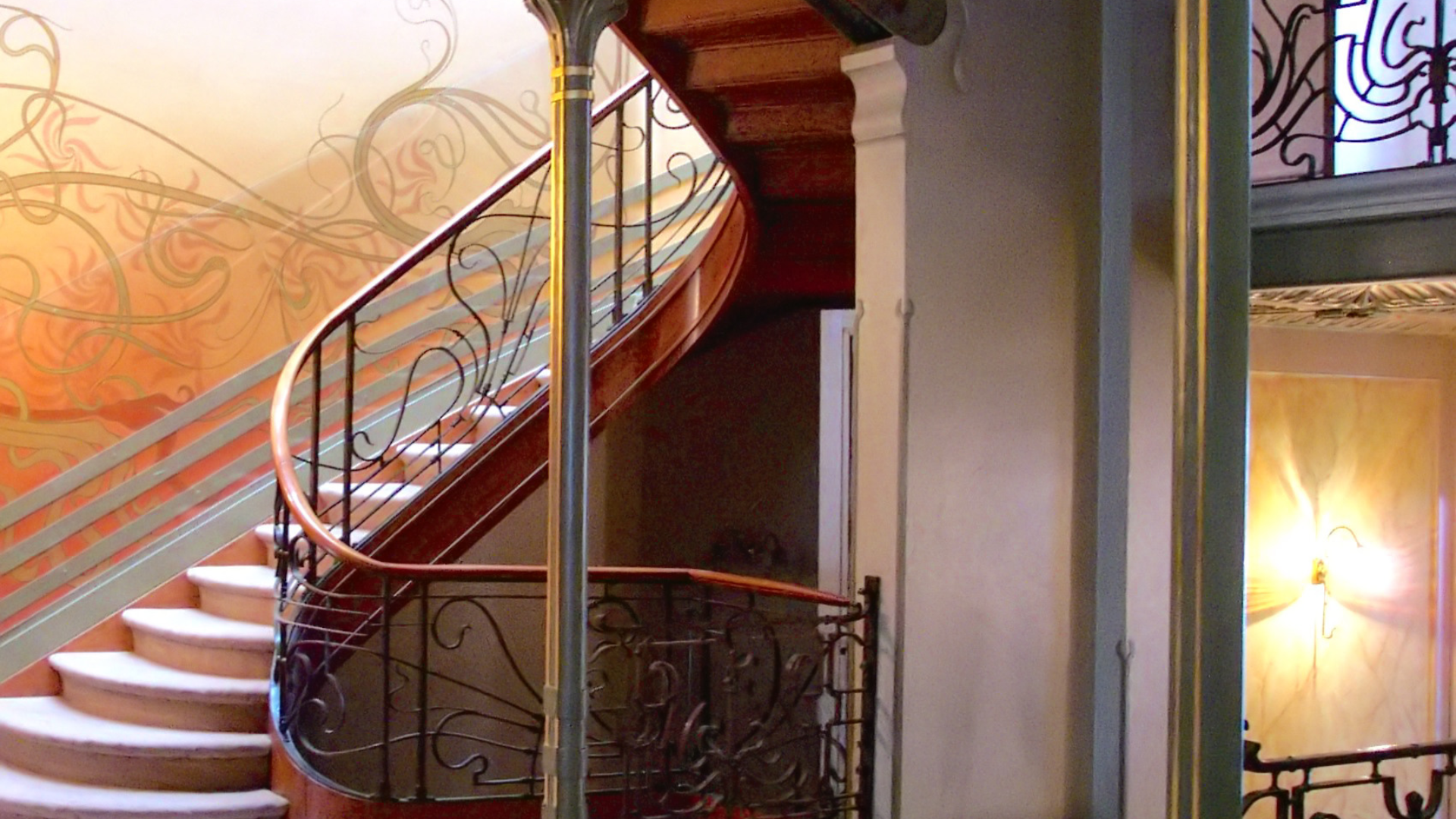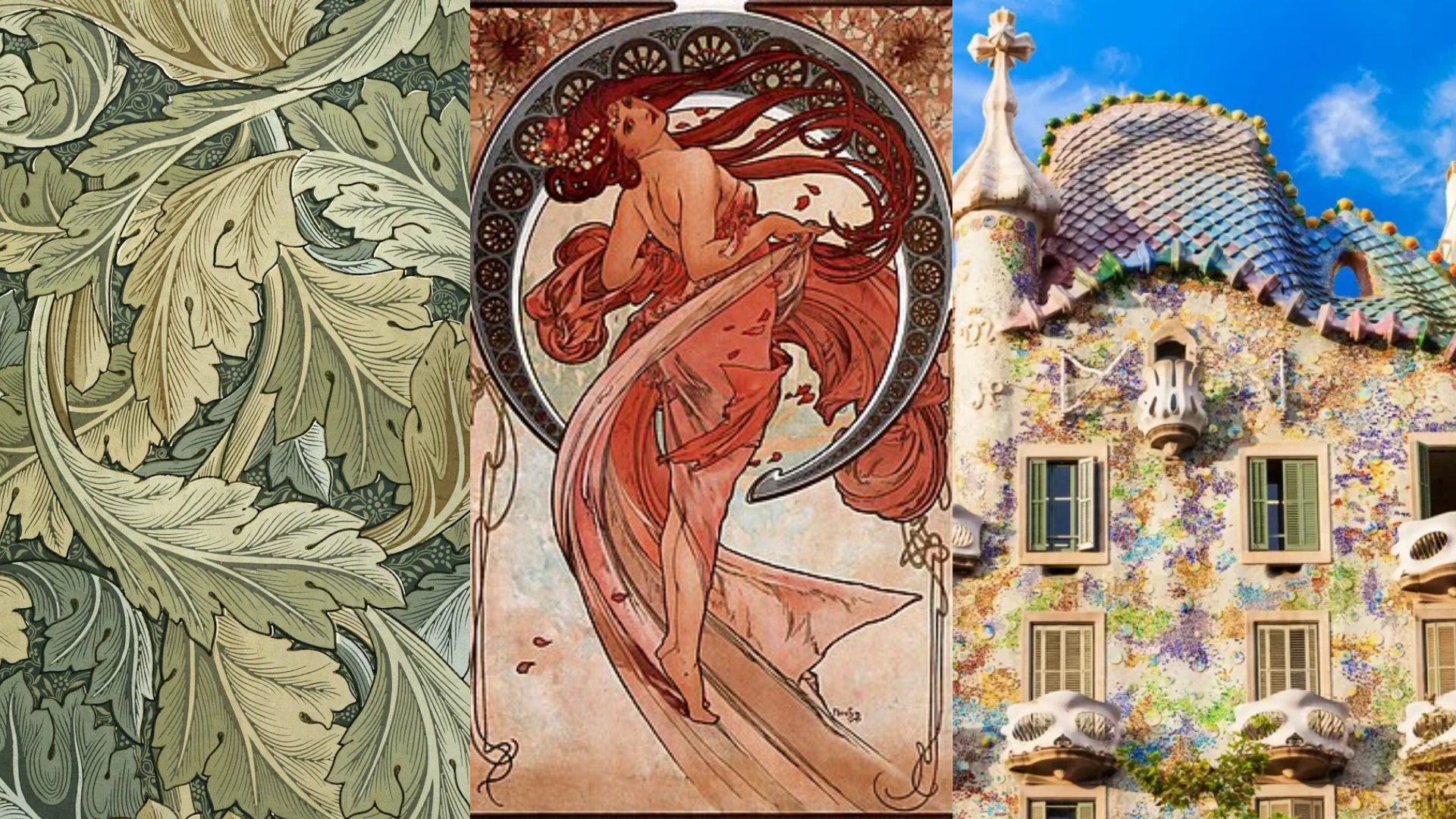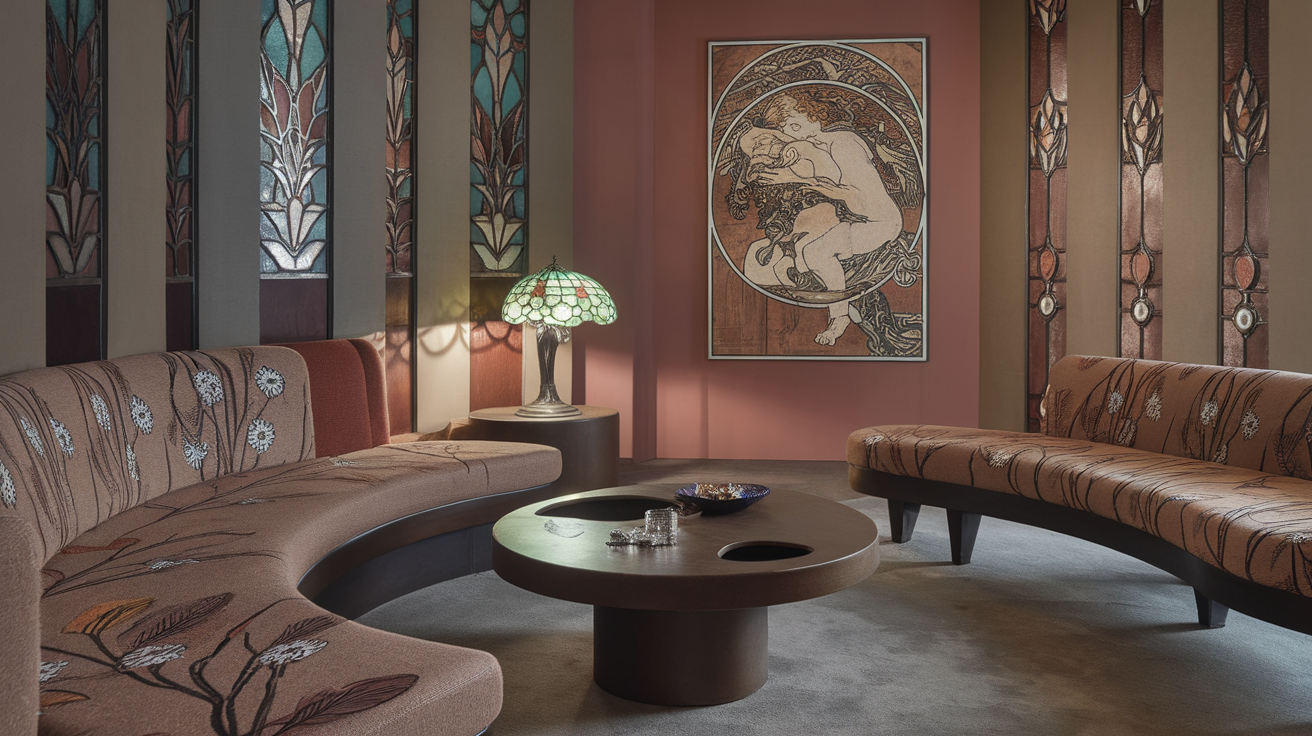Art Nouveau is a captivating movement that emerged in the late 19th century, offering a refreshing break from traditional design styles.
With its focus on blending natural forms and artistic expression, it introduced flowing lines, organic shapes, and intricate details that continue to inspire designers today.
In this blog, I’ll take you through the key characteristics, history, and stylistic elements of Art Nouveau, explaining why it remains relevant and influential in modern design.
Whether you’re an art enthusiast or simply looking to incorporate some Art Nouveau aesthetics into your space, I’ll guide you through its beauty and timeless appeal.
Let’s see how this unique style reshaped the world of art and design!
What is Art Nouveau?

Art Nouveau, which emerged in the late 19th century, was a revolutionary design movement that broke away from traditional styles and historic design conventions.
It sought to create a new, modern aesthetic, focusing on organic forms inspired by nature.
Originating in Europe, Art Nouveau artists rejected the rigid, historical designs of the past, favoring flowing lines, asymmetry, and intricate, natural motifs like flowers, vines, and insects.
This movement was not limited to visual art; it also encompassed architecture, furniture, jewelry, and graphic design.
By blending function and beauty, Art Nouveau sought to integrate artistry into everyday life, becoming a transformative force in both art and design that continues to influence contemporary aesthetics.
History of Art Nouveau
Art Nouveau, meaning “New Art,” originated in the late 19th century as a response to the Industrial Revolution’s mass production and rigid historical design styles.
It began in the 1880s in Belgium and France, where artists sought to create modern, organic designs inspired by nature. The movement spread rapidly across Europe, influencing countries such as Germany, Spain, and the UK.
By the early 20th century, Art Nouveau reached its peak, with notable figures like Hector Guimard and Alphonse Mucha shaping its development.
The style was widely seen in architecture, furniture, jewelry, and graphic arts, blending aesthetics with functionality.
However, as World War I approached, the popularity of Art Nouveau waned, giving way to the more geometric and streamlined Art Deco style.
Despite its short-lived nature, the influence of Art Nouveau still echoes in contemporary design today.
Key Characteristics of Art Nouveau

Art Nouveau is defined by flowing, organic lines, nature-inspired motifs, and intricate detailing. It embraces asymmetry, whiplash curves, and ornamental designs, creating a harmonious blend of art, architecture, and functionality.
1. Organic Forms
Art Nouveau is deeply inspired by the natural world, with designs often reflecting organic forms like plant tendrils, vines, flowers, and other botanical elements.
The goal was to create a more harmonious relationship between human-made objects and nature, making the design feel organic and alive.
2. Curving Lines
One of the defining features of Art Nouveau is its emphasis on flowing, curvilinear lines. These sweeping, sinuous curves are seen in everything from building facades to the design of furniture, light fixtures, and glasswork.
Unlike traditional straight lines, these curves evoke a sense of movement and natural growth, giving the designs a dynamic, fluid quality that reflects the beauty of nature.
3. Nature-Inspired Motifs
Nature was a central source of inspiration for Art Nouveau artists. Common motifs include floral patterns (such as lilies, roses, and irises), leaves, vines, and insects like dragonflies or butterflies.
These motifs were not only decorative but also symbolized the connection between the natural world and human creations.
The designs often featured intricate details that transformed ordinary elements of nature into stylized, elegant forms, resulting in visually stunning works of art.
4. Asymmetry
In contrast to the balanced, symmetrical designs of earlier art movements, Art Nouveau embraced asymmetry.
This characteristic reflects the natural world’s unpredictability and irregularity. The flowing, unbalanced forms created a more dynamic, spontaneous feeling.
This approach was applied to furniture, architecture, and even decorative arts, where traditional symmetry was replaced by shapes that felt more fluid and organically formed.
5. Intricate Detailing
Art Nouveau is known for its meticulous attention to detail. The movement emphasized craftsmanship and the beauty of the handmade, often featuring elaborate patterns and delicate ornamentation.
This intricate detailing was especially apparent in materials such as wrought iron, stained glass, and ceramics.
Even the smallest elements—like the curvature of a door handle or the framing of a window—would feature elegant, ornamental designs, elevating everyday objects to works of art.
6. Integration of Art and Function
One of the hallmarks of Art Nouveau is its belief that art should be part of everyday life. The style sought to merge aesthetics with functionality, creating beautiful objects that were also practical.
Artists and designers didn’t just focus on purely decorative elements; they worked to ensure that their creations, whether in furniture, buildings, or everyday items, were both functional and visually engaging works of art.
7. Whiplash Curves
A distinctive feature of Art Nouveau is the “whiplash curve,” which is a sharp, sweeping curve often resembling the shape of a whip’s lash. These dramatic, curving lines are seen in the design of everything from posters and furniture to architectural details.
The whiplash curve evokes a sense of fluidity and motion, helping to create a unique, dynamic visual style that differentiates Art Nouveau from previous design movements.
Art Nouveau vs. Other Art Movements
Art Nouveau is known for its flowing, nature-inspired designs, contrasting with the simplicity of Arts and Crafts and the geometric luxury of Art Deco, highlighting its unique organic style.
| Characteristic | Art Nouveau | Arts and Crafts | Art Deco |
|---|---|---|---|
| Origins | Late 19th century, reacting against industrialization. | The late 19th century focused on handcrafted simplicity. | 1920s-1930s, focused on luxury and modernity. |
| Design Style | Organic, flowing lines, nature-inspired motifs. | Simple, rustic, handcrafted, folk influence. | Bold geometric patterns, streamlined forms. |
| Materials | Glass, iron, ceramics with a decorative focus. | Wood, metal, textiles, and natural materials. | Chrome, glass, luxurious materials. |
| Motifs | Flowers, vines, insects, stylized natural forms. | Nature with simplicity. | Geometric shapes, zigzags, chevrons. |
| Craftsmanship | Detailed, blending art with function. | Focus on handcrafted work. | High craftsmanship with mass production. |
| Architectural Influence | Flowing, curved lines, nature-inspired facades. | Handcrafted, functional design. | Clean lines, modern skyscraper influence. |
| Legacy | Influenced modern design. | Lasting impact on sustainable, handmade design. | Ongoing influence in luxury and fashion. |
Influential Artists and Designers of Art Nouveau

Art Nouveau was shaped by many talented artists and designers, whose work left a lasting impact on the movement.
- Alphonse Mucha: A Czech artist known for his iconic posters featuring flowing lines and floral motifs. Mucha’s work in graphic design and advertising became central to Art Nouveau’s visual language.
- Hector Guimard: French architect famous for his innovative Paris Métro entrances. His use of wrought iron and organic shapes exemplified Art Nouveau architecture, merging functionality with decorative, nature-inspired designs.
- Louis Comfort Tiffany: An American designer renowned for his stained glass windows, lamps, and jewelry. Tiffany’s nature-inspired designs and vibrant use of color made his work iconic in the Art Nouveau movement.
These artists, along with many others, helped to define Art Nouveau’s distinctive aesthetic, blending beauty, functionality, and nature-inspired designs into everyday life.
How to Incorporate Art Nouveau in Modern Spaces

Art Nouveau might sound fancy, but it’s easy to use in a modern space. It’s all about natural shapes, soft curves, and pretty details.
If you like a bit of old-school charm mixed with today’s look, this style can be a fun way to decorate without going over the top.
- Choose furniture with curved, flowing shapes and floral details
- Use lighting with stained glass and curved metalwork (like chandeliers or lamps)
- Hang wall art such as Alphonse Mucha prints and mirrors with organic frames
- Add decorative accents like floral textiles, art glass, and sculptures
- Include architectural features like curved windows and wrought iron railings
- Stick with earthy colors (greens, browns) and deep jewel-tone accents
You don’t have to change everything to bring in Art Nouveau. A few simple touches, like curved furniture, floral patterns, or cool lighting, can make a big difference.
It’s an easy way to add style and a bit of personality to your home while keeping things cozy and modern.
Art Nouveau’s Legacy Today
Art Nouveau continues to influence modern design across architecture, interior design, and contemporary art. While the movement was short-lived, its flowing lines, organic forms, and nature-inspired motifs remain relevant.
In architecture, Art Nouveau’s emphasis on curving, asymmetrical lines can still be seen in modern buildings, blending beauty and functionality.
Interior design embraces Art Nouveau through furniture, lighting, and textiles that incorporate nature-based patterns and intricate craftsmanship.
The movement’s attention to detail and organic forms continues to be admired in high-end design today.
In contemporary art, many artists draw inspiration from Art Nouveau’s themes of nature and elegance, creating works that evoke the fluidity and beauty of the movement.
Art Nouveau’s legacy lives on, influencing design and art, providing timeless inspiration for modern creators, and transforming spaces into beautifully crafted environments.
Conclusion
Art Nouveau is a captivating style that combines natural beauty with artistic innovation. Its flowing lines, organic shapes, and intricate detailing continue to influence design and art today.
I’ve shared the defining characteristics and history of this movement, along with key figures who shaped it, but the beauty of Art Nouveau extends beyond just what we see in galleries.
The movement’s blend of nature and design offers endless inspiration for creating elegant, functional spaces.
I encourage you to think about how elements of Art Nouveau—whether in furniture, architecture, or decorative arts could transform your own surroundings.
This timeless style remains as relevant today as it was over a century ago, offering a fresh yet classic way to bring nature into your living space.
Ready to incorporate some of this beauty into your home? Let’s make it happen!

